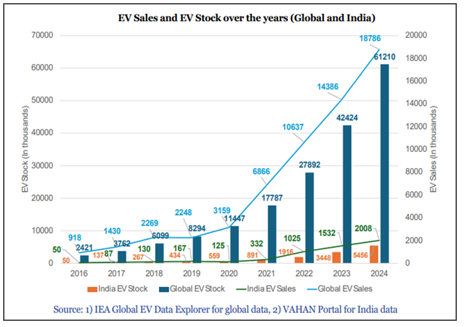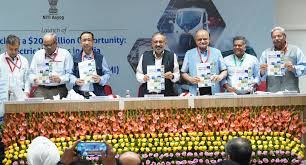SYLLABUS
GS-3: Science and Technology- developments and their applications and effects in everyday life.
Context:
Recently, NITI Aayog launched its report titled “Unlocking a $200 Billion Opportunity: Electric Vehicles in India,” highlighting major unlocks essential to accelerate India’s Electric Mobility transition.
Key Highlights of the Report
- The report aims to provide a comprehensive assessment of the current challenges and strategic recommendations needed to accelerate India’s transition to electric mobility.
- India has decided to aggressively move towards electric mobility.
- Serves as a Blueprint: It identifies key barriers, strategic unlocks, and actionable recommendations to accelerate EV adoption.
The key objectives are:
- Reduced dependence on imported fuel
- Increased share of renewable energy by leveraging the storage capacity of EV batteries
- Reduced Greenhouse Gas (GHG) emissions
- Improved air quality
- Improved Plant Load Factor (PLF) of electricity-generating plants
- Becoming a leader in a rapidly growing global market
Challenges to EV adoption are:

- Challenges of financing vehicles, especially electric buses and electric trucks, due to several risks perceived by financial institutions.
- Inadequacy of charging facilities on one hand and low utilisation of existing public charging facilities on the other.
- Lack of adequate awareness regarding EV performance among public and private stakeholders.
- Inadequate data and regulatory gaps hinder evidence-based decision making.
Status of electric vehicles in India as per the report
- Target: India aims to achieve a 30% share of electric vehicles in total vehicle sales by 2030.
- Growth Trajectory: EV sales in the country have increased significantly – from 50,000 units in 2016 to 2.08 million in 2024.
- India’s EV penetration: About one-fifth of the global penetration in 2020, but has picked up to over two-fifth of the global penetration in 2024.
- India is doing well with electric two-wheelers and electric-three wheelers. With regard to electric buses, it has made some progress, but with electric cars it has been slow. Long haul electric trucks have virtually not taken off.
- India has progressed to only about 7.6 % of the sales in 2024 being electric, which is far behind its target of 30% by 2030. Thus, it has taken nearly 10 years to reach a penetration level of 7.6% and now needs to increase this share by over 22% in the next 5 years alone.
Government initiative to promote electric Vehicle
• Faster Adoption and Manufacturing of (Hybrid &) Electric Vehicles in India (FAME India):
- It operates in two phases

• PM E-DRIVE Scheme (PM Electric Drive Revolution in Innovative Vehicle Enhancement): It aims to support electric vehicles, including e-2W, e-3W, e-Trucks, e-buses, e-Ambulances, EV public charging stations and upgradation of testing agencies.
• Goods and service tax (GST) rate on all Electric Vehicles reduced from 12% to 5% and of charger or charging stations for EVs from 18% to 5%.
• Phased Manufacturing Programme (PMP): It has been adopted which encourages domestic manufacturing and strengthening of EV supply chain and aims to promote indigenous manufacturing of electric vehicles.
• The government has proposed the exemption of registration fees for battery operated/electric vehicles to promote eco-friendly vehicles in the country.
Source:



